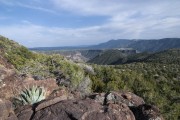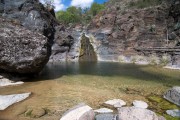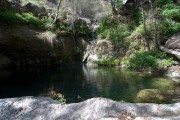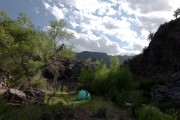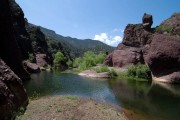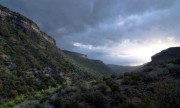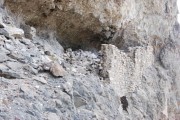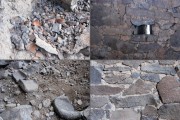Into the Mazatzal Wilderness once again. This time I tried an area north of the East Verde River. I studied the map and found an interesting rough canyon section and decided to explore that. Kind of a slow trek, but well worth the effort. Saw some great areas. The trek started at the 6000′ Twin Buttes trailhead leading out onto the mesa top. This is cow country – and I knew that going in – so you run into them up here and occasionally in the canyon bottom. The trail started off rough and pretty chewed up from horse or cow travel after a previous rain. I was looking forward to getting off-trail.
After hiking the trail for a few miles, I headed off across the mesa to a section of canyon that appeared to be a less steep entry to the canyon bottom. But it still was quite brushy going down with loose rocks and a steep incline not helping at all – slow going. The bottom was rough too and brushy in spots with drops that required a bit of re-routing.
The first night, I got to the canyon bottom and camp fairly late due to my late start – so I pitched where I could find any flat spot for the tent and some water. Finding tent locations on this trip was a real task. The canyons are narrow, somewhat brushy and rugged overall.
The canyon I descended into was a branch leading into Greenhorn canyon. At this time of year, water generally isn’t too hard to find. There may be dry sections of canyon, but you can pretty much look at the map and see where water will generally accumulate – tight, narrow, North-South canyons are a good bet.
After just entering Greenhorn canyon, I came upon a steep dropping section of canyon. Here the water flowed over two steep barriers and into these beautiful large and deep pools. The upper tank was probably 30 feet across maybe ten deep. This tank saw little shade, but was so deep, I can’t imagine it going dry in the summer months. Just below the upper tank the creek dropped again into this beautiful oasis of plants and flowers. Well shaded by the canyon walls and the willow and sycamore trees this was an amazing little spot.
The next day it was down the canyon toward the East Verde. I came across many beautiful spots along the creek. There were a couple of sections where the canyon dropped and narrowed to the point where I was forced to go up and around, but nothing too difficult. In the lower reaches of the canyon the creek was full of small fish – up to about 6 inches that probably end up down in the East Verde or Verde proper.
The East Verde was the “big” river on this trip. It was a dry winter and the East Verde was low. Easy to rock hop across or wade if you so chose. I camped at the junction with Greenhorn Canyon. Beautiful grassy spot with a sandy beach and pretty cliff walls. The up-river section from here narrowed a bit and required a wade across the muddy bottom if you wanted to explore that direction. I enjoyed two nights here. I explored down river the next day.
This area is the upper elevation for saguaro cactus and ocotillo, which grow here on the warmer south facing slopes of the canyon. This is where the juniper and the saguaro regions meet with pinyon pine still a bit higher up.
My second night on the East Verde I had some clouds come in making a beautiful evening, warm and peaceful. I laid out on the rocks that evening after sunset, enjoying the quiet when a hawk swooped just above me, absolutely silently. It climbed sharply and grabbed a swallow from below in mid-flight, with its wings hitting the prey and breaking the silence. Stunning and brutal.
A little bit of backtracking led me to The Gorge, a connector canyon leading into Greenhorn Canyon. The Gorge didn’t have running water through most of the canyon. It was mostly bouldery and dry. This made hiking slow and rough on the ankles. There were some very nice sections where the water came to the surface and flowed nicely, but never very much water. Greenhorn canyon, which was a smaller watershed, carried more water. When it did get wet through here and the section wasn’t extremely rugged, the cows would pretty much chew everything up – cattails being a favorite of theirs… a shame really.
With names like Hieroglyphic Canyon and Indian Spring, you know that human history is tied to the places. And wondering about this one morning, I look up on the canyon wall to see what was obviously a man-made structure. In a cave entrance, stacked rocks – an Indian cliff dwelling. Completely off the map and in some obscure area, I hadn’t found anything like this before on my trips… so I climbed up a hundred feet or so above the creek bottom to investigate. This was a small 3 room affair, with nice view and good shade. But a steep hike from the creek bottom. It was nicely
constructed, but somewhat rundown over the years. You could still see the nice handiwork in the masonry constructed of available rock and mud. Pot shards littered here and there with a pair of grinding stones laying about. A couple of view-ports were constructed in the walls which pointed directly down to the creek bottom.
After a few miles of canyon rockhopping and gaining about 2000 feet from the East Verde, I left The Gorge and headed back up onto the mesas – and back into the juniper belt. The next few miles of mesa top hiking was easy – a real expressway – and after grinding through the last few days of rough canyon work a welcome change.
Tags: Backpacking, Canyons, Desert Hiking, Indian Ruins, Off-Trail Hiking

